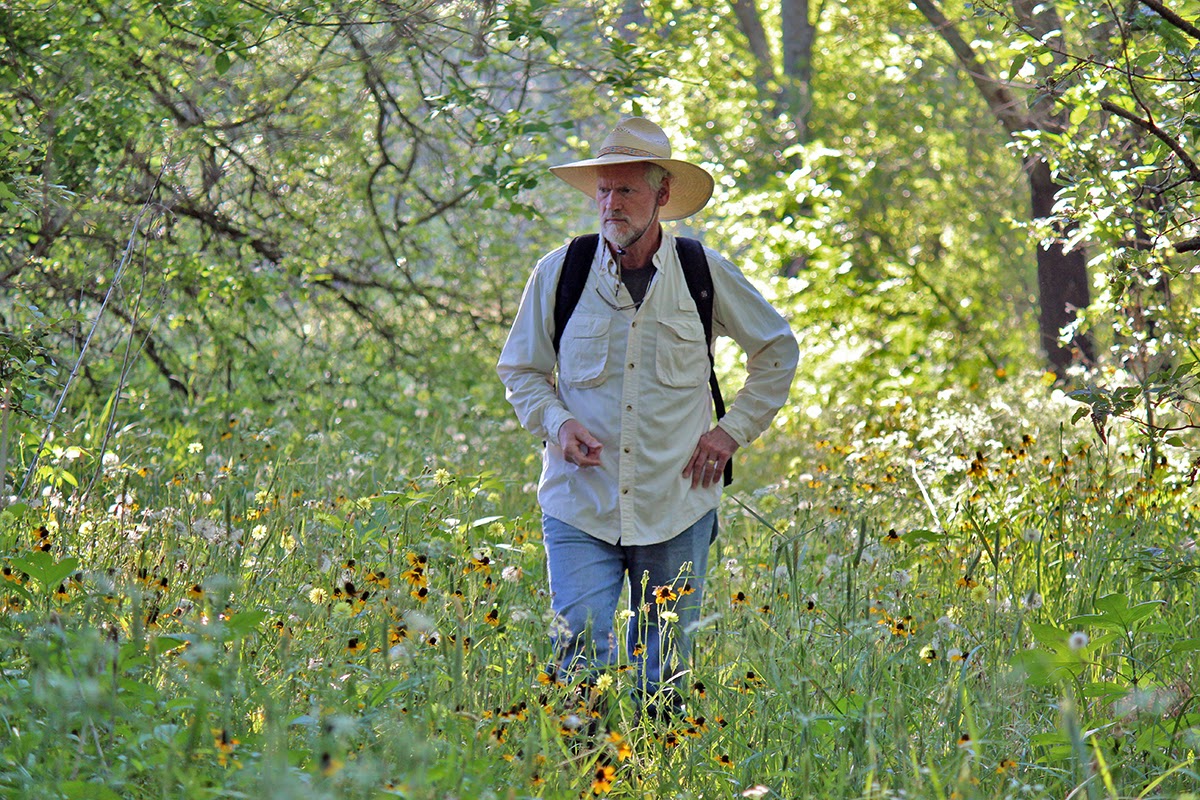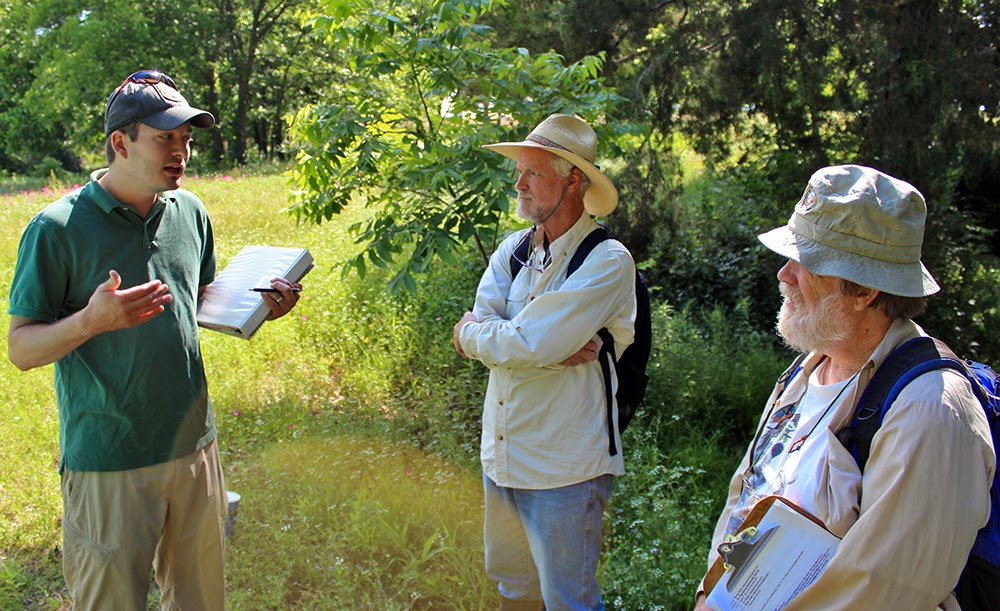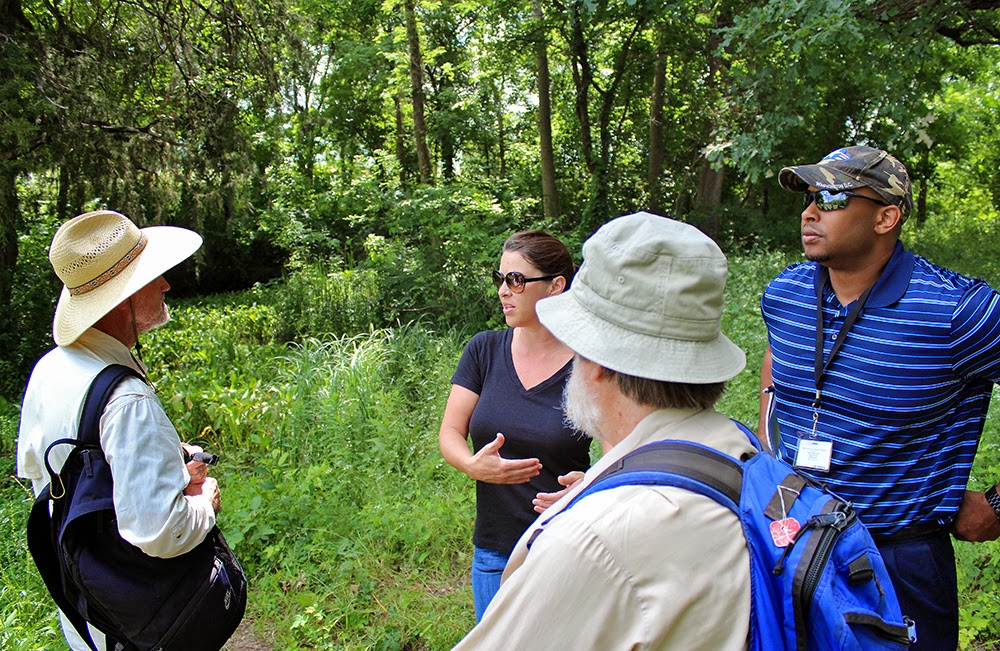Big Spring’s Rare Plants Roar Into The Record Books Of Texas Botany
It was a cool August 1st in the year 1902 that the world famous pioneer Texas botanist Julien Reverchon would have been found collecting plants by horseback in the sandy soil east of what was then Dallas. One of the plants he collected that summer day was that of the Smooth False Buttonweed Spermacoce glabra. 112 years later in 2014 and modern day North Texans are probably not familiar with the sight of the plant, one whose native habitat of swamps and wetland areas no longer exist in Dallas. Not a rare plant points east in the Mississippi Valley but exceptionally rarely seen in the Trinity drainage and especially Dallas County. A species thought to be extirpated, a local extinction due to habitat loss and lack of sightings. Reverchon’s collection site, the once well known to every Dallasite, Buzzard Spring does not even exist. Destroyed through channelization, infill and development, the ancient swamp became urbanized and forgotten from memory.
Many contemporary Dallasites associate the name Reverchon with a park bearing the same name on the popular Katy Trail. Few know that the man behind the name forever changed how Dallas was viewed abroad as a growing town of refining culture and class. Julien Reverchon’s observations and collections drastically changed how the North Texas landscape was seen and written about in late 19th century dissemination and publication.
 |
| The long lost Spermacoce glabra rediscovered at Big Spring 2014 |
Julien Reverchon (1837-1905) was a pioneer of the La Reunion colony in what is now West Dallas/Oak Cliff. Reverchon’s family immigrated with La Compagnie Franco-Texienne to Texas in 1856. The eclectic colony of French, Swiss and Belgian immigrants settled in 1855 at La Reunion across the Trinity from Dallas. Within eighteen months the colony of artisans, musicians and philosophers was more of a marked failure than success. Julien’s family led by his father Jacques Maximilien Reverchon arrived in 1856, seeing the less than stellar gains of La Reunion as a community, purchased land to the southeast from the Anson McCracken Survey near present day Davis and Hampton Roads.
It was here on the family farm, later coined Rose Cottage that Julien Reverchon began his study and collection of plants in Texas. At the time North Texas was still very much a frontier with Indian raids, cattle drives and true wilderness out the front door of any home on Main Street. The natural environs around North Texas were completely undocumented and explored to any degree. The rough hewn lines of surveyors marks on maps and the occasional fence were the only boundaries of note.
 |
| A bumblebee visits a Milkweed at Big Spring, Dallas, Texas as a summer thunderhead rapidly builds 5 miles to the north over White Rock Lake, July 2014 |
Unpeopled and undeveloped North Texas was land ripe for discovery. For the next fifty years, Julien Reverchon studied and collected the plants of Texas. His well documented excursions to West Texas with famous Swiss scientist Jacob Boll and Harvard’s Asa Gray led to new plant species on every trip. Gray named the genus Reverchonia in Julien Reverchon’s honor. Others in the scientific coterie bestowed Reverchon’s work by naming species of aristida, diplachne and panicum in his honor. Botanist Charles Sprague Sargent of Harvard University and author of North American Silva named Crategus reverchoniia a type of local Dallas Hawthorne tree for Reverchon. The list goes on and on.
Thousands of plants were collected and distributed by Reverchon to universities of high standard at the time. These plants, many of which were unknown at the time became groundbreaking additions to collections being studied for pharmacutical and medicinal use. One such field trip to collect plants was August 1, 1902.
 |
| Closer view of the BRIT archived herbarium of Julien Reverchon, with notation “sands east of Dallas”. Photo courtesy Master Naturalist Jim Flood |
 |
| Bank of America Building as seen from Big Spring |
As a resident of Dallas, Reverchon made numerous trips afar collecting plants but based much of his effort in Dallas County. Many of his collection site describe places known and unknown to current residents, White Rock Creek, Turtle Creek, Trinity River, Oak Cliff. Others are slightly vague in descriptor, like “rocky outcrop”, “river bottom”, “rocky soil”. In the case of the photo card at the beginning of the post Spermacoce glabra is noted in “sands east of Dallas”.
The record of Reverchon’s trip that day in August 1902 was immortalized in plants collected in the field. To preserve their form and color, plants collected in the field are spread flat on sheets of newsprint type medium and dried, usually in a plant press, between blotters or absorbent paper. The specimens, which are then mounted on sheets of stiff white paper, are labeled with all essential data, such as date and place found, description of the plant, soil and special habitat conditions.
 |
| Hurricane #2 track over Texas summer 1902 |
By Texas standards, the summer of 1902 was an abnormally cool and wet season with large tropical systems moving across the state with great frequency. In late June and into early July, Hurricane #2 which made landfall in Port Lavaca slowly ground across Texas dumping record rains on the Sabine, Brazos and Trinity River basins. The farm reports from that autumn posted record yielding crops of cotton and corn in North Texas.
Bumper crops parallel bumper conditions of native flora as well. A great period for documenting the water loving swamp plants of Dallas. Many of the plants that Reverchon collected were native grasses, sedges and plants that were studied for medicinal uses and agriculture.
Solving the puzzle of Buzzard Spring
The complete picture of what Reverchon collected that day in 1902 requires some detective work to trace. Scattered across herbarium collections in Texas, Missouri and Massachusetts the puzzle pieces were hard to pull together. When Jim Flood contacted me about his rare find at Big Spring of Smooth False Buttonweed and that Julien Reverchon had collected the same species at a vaguely described spot east of Dallas, the hunt was on for more information. The off-chance to tie the collected species together in the same creek drainage was a distinct possibility.
 |
| Searching the herbariums across the country provided lists of species collected by Reverchon on August 1, 1902 |
I knew that the descriptor “sands east of Dallas” most likely meant an area not far from the city proper. Using different databases and searches I was able to find other plants collected the exact same day by Reverchon.
What we have from Reverchon are his botanical tags cut from the original paper and pasted onto newer sheets. The tags contain brief notes on species collected, date, location, collected by whom and conditions under which collected. Keen observational powers and a systematic approach are what Reverchon is known for, his notes solved a part of the equation in 2014.
Buzzard Spring once sat east of what is now Fair Park in what old texts describe as “swamp” or “marsh”. The location today would be very near 32.774641,-96.741704 near the intersection of Spring Ave and Wahoo.
Looking back through Reverchon’s collection records he has visits to gather plants here at Buzzard Spring and the woods beyond dating to as early as 1876. Nearly three decades of regular visits to this spot, well documented through his collection. 1876 was a banner year for Reverchon discovering a dozen new plant species. Further work in the years to come added on that groundbreaking work.
 |
| Allionia gigantea Standl collected at Buzzard Spring by Julien Reverchon August 1, 1902 from the botanical information system at the Missouri Botanical Garden – www.tropicos.org |
Walking those wooded slopes and fields, set only a few miles from what was then outside the city limits of Dallas one can only imagine what Reverchon experienced when looking for plants here. Buzzard Spring fed Wahoo Lake or Lake Wahoo, a natural water body known to 19th century Dallasites as a good fishing spot. This was a time before area lakes were built, even before White Rock Lake. Ponds and lakes did not exist to any degree at the time, Wahoo was a popular spot for residents.
The land was first settled by the Beemans who owned near continuous tracts of land between what is now Fair Park and the Trinity River Audubon Center. One recollection from the early settlement of Buzzard Spring comes courtesy of historian MC Toyer from a memoir passage of JJ Beeman describing the lake area in the 1840s. The blockhouse mentioned would be just south of present day Military Parkway on the west side of White Rock Creek and behind the Beeman Cemetery east of Dolphin Road:
John’s family and mine lived in the block house until we built another house close by. I had selected me a place about a mile southwest of the block house and built a house in the timber where there was a fine pool of water with plenty of fish in it. By this time we had become somewhat careless and would venture further than we had before, so in order to be convenient to my work I built a camp and moved to the place before I built the house– James Jackson Beeman, Memoirs.1886.
Buzzard Spring fed into what we now call the Great Trinity Forest, a vast urban bottom land that so few current Dallasites have seen with their own eyes. Some of the plants collected by Reverchon in this area no longer are known to exist in Dallas. Or are they? They have not been seen by anyone alive in generations and all but forgotten.
As Dallas growth marched east at the turn of the last century, Buzzard Spring and Wahoo Lake were filled in and dewatered. Gone forever.
Rediscovering Reverchon’s Work Through Botany At Big Spring
 |
| This photography event at Big Spring was through the North American Nature Photography Association one of the cornerstone initiatives to expose more people to the Great Trinity Forest |
It remains one of the wildest places left in Dallas County. It has always been this way. Since before the Pembertons. Since before the pioneer Beemans. Since before the Caddo. Wild. Farther off the beaten path than anywhere else inside Loop 12. Farther from concrete anywhere inside Loop 12. Here among the outfall of another natural spring outfall in the White Rock Creek watershed called Big Spring lies the ever growing realization that the land here offers a refugium for rare plants thought to have been lost in Dallas.
 |
| Spermacoce glabra in full bloom at Big Spring in the Great Trinity Forest July 2014 |
Bursting into bloom are the plants maybe just three or four people alive have ever seen blooming in Dallas. The Spermacoce glabra Smooth False Buttonweed is just one of a growing number of plants that simply are not found in this part of Texas with regularity.
 |
| Master Naturalist Jim Flood |
It was Master Naturalist Jim Flood and Geoarcheologist Tim Dalbey who first found the plants during a weekly plant survey at Big Spring in late June 2014. Jim Flood is most well known as the trail steward for the Buckeye Trail in Rochester Park, about a mile as the ibis west from Big Spring. Jim’s tireless work in the Great Trinity Forest often goes unappreciated and under-recognized.
It seems rather impossible for many to understand Jim’s important contributions to the well-being of the Great Trinity Forest and how his foundation of efforts over the years will most likely serve as a launching pad for the future.
 |
| Spermacoce glabra Dallas, Texas July 2014 |
 |
| Eastern Bluestar Amsonia tabernaemontana at Big Spring 2014 |
A number of other plant species not traditionally seen in the area are also being found. Species in the Dogbane family like the Eastern Bluestar Amsonia tabernaemontana have been documented this spring and summer of 2014. Like the Buttonweed, these plants live in wetlands, marshes, ephemeral wetlands and wet meadows. This is another species identified by Tim Dalbey and Jim Flood in 2014 at Big Spring.
Biodiversity at 265+ plant species and counting
 |
| Master Naturalist and DFW Texas Stream Team coordinator Richard Grayson walking among the thigh high wildflowers at Big Spring in the bottoms. The Eastern Bluestar plants are just to the right. |
 |
| Non-flowering Eastern Bluestar at Big Spring’s large wildflower meadow 2014, Brett, Sarah, Aaron in the background 2014 |
Expanding on plant species data is just one aspect of the work at Big Spring in 2014. Tasked on a whiteboard discussion at Dallas City Hall in late 2013, scopes of work were outlined for the new year. Historical designation, water quality testing, flora-fauna surveys and public access were cornerstones to be established and built upon.
 |
| Brett Johnson, Paul White, Aaron Schad, Sean Fitzgerald |
Lots of meetings and discussions on the issues at hand. How best to develop a management plan for this unique area and how to maintain it for generations to come. The absence of human disturbance has left much of the ecological functionality of Big Spring intact indicating that preservation and management of the site should be somewhat of a “hands ‐ off” or “less ‐ is ‐ more” approach.
The limited human management will allow the natural processes to continue undisturbed. Continual monitoring and assessment of Big Spring will allow decisions to adaptively develop or hone site specific management.
From this eclectic mix of individuals a greater understanding of Big Spring has emerged and will continue to expand in the future. Quarterly plant and wildlife inventories, water testing and future planned projects merely scratch the surface. The ability for these citizens to do things the right way, the first time is just what Big Spring needs.
The approach to managing the spring has been driven by a deep pool and knowledge base of experts in professional disciplines of science, education, archeology, history and engineering. Some of this work comes from the membership of the North Texas Master Naturalists who have been helpful as a guiding hand in future management plans.
Working More People Into The Fold
One of the many cornerstones laid with work this past winter were plans to draw more people into the mix at Big Spring and the Great Trinity Forest. It seemed like a simple idea to broaden the horizons of many who had never experienced the vast areas of the Great Trinity Forest, off the beaten path. How to do that is a bit complicated with larger groups.
 |
| Sunset over Big Spring after a heavy late day thunderstorm |
The exposure for many Dallasites to the Trinity River is that seen through a car window at 60mph or from a visit to the Trinity River Audubon Center(TRAC). Lots of great views from bridges or from the TRAC trails but there is so much more beyond that.
 |
| Big Spring |
Photographer Sean Fitzgerald suggested using the framework of a website called Meetup and a
photography organization called NANPA, the North American Nature Photography Association. Through the website and the organization, Sean suggested cherry picking the very best weekends at the peak of bloom for sites around the Great Trinity Forest.
 |
| Barred Owl seen at the NANPA Photo-Hike Buckeye Trail |
 |
| NANPA event in the GTF, checking out a Barred Owl |
The first was the Trinity Audubon Center in the Great Trinity Forest, an after hours event in the golden hours before sunset. The second was a late March visit to the Texas Buckeye Trail in Rochester Park and the third was in May at a day long event at Historic Big Spring.
We had some candid discussions about how to best get more people aware and interested in the Trinity. If you look at what product is turned out every year for things like the Trinity River Photo Contest, you realize that the photographers and public in general have yet to really get down into the forest and experience the real nature that resides there. So much goes unseen and undocumented down on the river with only a few sets of eyes even visiting these grand places. It’s a shame because vast stands of flowering trees and fields of wildflowers go to bloom without ever being enjoyed or visited.
These well attended events this spring exposed many dozens of people to the Great Trinity Forest and to places few have even seen before. Their photos, shown in a gallery of over 100 images Big Spring NANPA event highlight through the eyes of dozens, the beauty and nature at Big Spring. The main website is here NANPA Photography Group of North Texas.
The desire to preserve what’s authentic, what holds substance and what aspires to the whole shines through the experience of those who visit. The future looks brighter than ever for Big Spring. A picture is emerging of knowing a place intimately that only the giants of Texas history like Julien Reverchon ever knew. The pioneer spirit is still alive here. Those belonging to it more fully and to take responsibility for its preservation feel it in the work they do.
 |
| Ground fog developing in the pre-dawn light across the millions of wildflowers at Big Spring. Thirty second exposure in near total darkness at 5am. |











